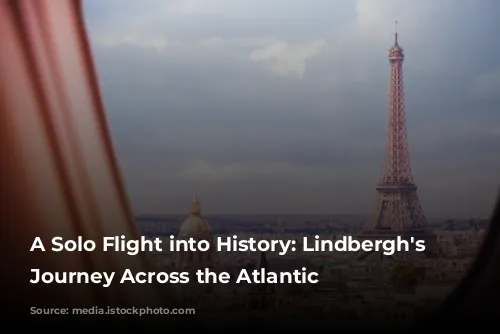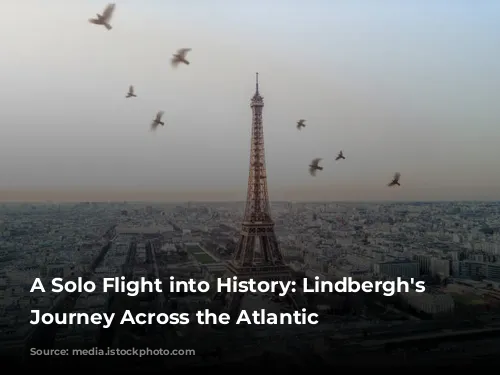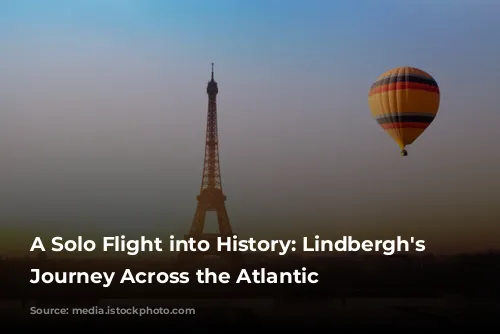On May 20, 1927, Charles A. Lindbergh embarked on a journey that would forever change aviation history. Taking off from Long Island’s Roosevelt Field in a single-engine Ryan Airlines plane named “Spirit of St. Louis”, Lindbergh set out to achieve the seemingly impossible: to fly solo across the Atlantic Ocean. This daring endeavor was not just a race against the elements or a test of navigation skills; it was also a grueling battle against fatigue. The previous night was filled with preparations, keeping Lindbergh awake, but he managed to stay alert enough to guide his plane safely to Le Bourget Aerodrome in Paris, France, 33 hours and 30 minutes after his departure from New York.
This article will take you on a step-by-step journey through Lindbergh’s epic flight, highlighting the challenges he faced and the remarkable milestones he achieved. Let’s follow the “Spirit of St. Louis” as it soars through the skies, and experience the thrill and tension of this historic adventure firsthand.

Taking Off: The First Steps
A heavy “Spirit of St. Louis”, laden with 450 gallons of fuel, took off from Roosevelt Field at 7:52 am. The plane barely cleared the telephone wires at the end of the runway, leaving just 20 feet to spare. This was a clear indication of the demanding journey ahead.
As the plane climbed to 500 feet, Lindbergh flew over Rhode Island, encountering only some minor turbulence. The flight over Long Island Sound and Connecticut was uneventful, leaving him with 3,500 miles to go before reaching Paris.

Navigating the Coastline: The Early Hours
The “Spirit of St. Louis” continued its journey, leaving Boston behind and Cape Cod on its right. At an altitude of 150 feet, Lindbergh maintained an airspeed of 107 mph.
Despite the smooth flight, fatigue started to set in just four hours after takeoff. To combat drowsiness, Lindbergh descended to just ten feet above the water, using the close proximity to the ocean to keep his mind sharp.

Battling the Elements: The First Day
The wind picked up, blowing from the northwest at 10 mph. Lindbergh had already flown over 400 miles, with Nova Scotia on the horizon. The “Spirit of St. Louis” was only six miles off course, demonstrating Lindbergh’s remarkable navigation skills.
The flight continued over the Gulf of Maine, but as the plane approached a storm front, clouds started to gather, threatening the journey. To avoid the storm, Lindbergh adjusted his course, flying at an altitude of 600 feet.

Enduring the Night: Facing Darkness and Fatigue
As the first day of the flight drew to a close, the sun dipped below the horizon. Navigating by the stars, Lindbergh encountered dense fog that obscured the sea below. To stay above the rising clouds, he climbed to 7,500 feet.
With the night came a battle against exhaustion. Lindbergh considered closing the plane’s windows to keep warm, but realizing he needed the cold air to help stay awake, he chose to endure the chill.

The Second Day: Hope and Hallucination
The sunrise brought a glimmer of hope, signifying the halfway point of the journey. Lindbergh, however, felt only dread, knowing that eighteen long hours were still ahead.
He continued to fight against exhaustion, sometimes falling asleep with his eyes open, awakening only moments later. Hallucinations started to set in, adding another layer of challenge to the already difficult journey.

The Final Stretch: Land in Sight
As Lindbergh approached the end of his journey, he spotted several small fishing boats and attempted to call out for directions. However, the fishermen were not on deck, leaving him to rely on his own navigation skills.
The “Spirit of St. Louis” spotted land to its left and veered towards it. Using his charts, Lindbergh identified the land as the southern tip of Ireland, confirming that he was only three miles off course.

The Triumphant Landing: A Moment for History
With the sun setting, Lindbergh pushed the plane to its limits, reaching an airspeed of 110 mph to ensure he reached the French coast in daylight. The English coastline appeared in the distance, and Lindbergh, now wide awake, continued his flight.
As the “Spirit of St. Louis” flew over Cherbourg, the French coastal town, Paris was only 200 miles away. Finally, at 4:22 pm local time, after a total flight time of 30 hours and 30 minutes, Lindbergh landed at Le Bourget Aerodrome in Paris. He had completed his epic flight, achieving the impossible, and had not slept for 55 hours.
Conclusion: An Unforgettable Journey
Charles Lindbergh’s solo flight across the Atlantic Ocean was a testament to human courage, determination, and resilience. He not only conquered the physical challenges of flying a single-engine plane over thousands of miles but also overcame the mental and physical strain of enduring 55 hours without sleep. This historic flight marked a turning point in aviation history, inspiring countless others to dream of conquering the skies. Lindbergh’s journey, captured in every detail, continues to be a story of human triumph and a reminder of the boundless possibilities that lie within us all.





